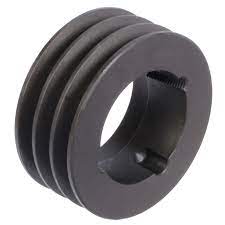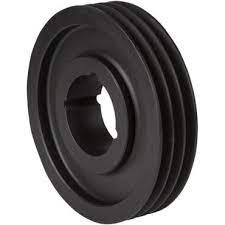Product Description
MIGHTY manufacture different types pulleys as follows:
1) European standard:
a) V-belt pulleys for taper bushings: SPZ, SPA, SPB, SPC; up to 10 grooves
b) Adjustable speed V-belt pulleys and variable speed pulleys
c) Flat belt pulleys and conveyor belt pulleys
2) American standard:
a) Sheaves for taper bushings: 3V, 5V, 8V
b) Sheaves for QD bushings: 3V, 5V, 8V
c) Sheaves for split taper bushings: 3V, 5V, 8V
d) Sheaves for 3L, 4L or A, and 5L or B belts: AK, AKH,2AK, 2AKH, BK, BKH,2BK, 2BKH, 3BK
e) Adjustable sheaves: poly V-pulley, multi-pitch H, L, J, K and M
Parts can be made according to drawings and/or samples, OEM service is welcomed
3) Bore type: pilot bore, finished bore, taper bore, bore for QD bushing
4) Surface finish: paint, phosphating, zinc plated
5) Material: cast iron, ductile iron, nylon, aluminum
6) Made according to drawings and/or samples, OEM inquiries welcome
Main Products:
1. Timing Belt Pulley (Synchronous Pulley), Timing Bar, Clamping Plate;
2. Forging, Casting, Stampling Part;
3. V Belt Pulley and Taper Lock Bush; Sprocket, Idler and Plate Wheel;Spur Gear, Bevel Gear, Rack;
4. Shaft Locking Device: could be alternative for Ringfeder, Sati, Chiaravalli, Tollok, etc.;
5. Shaft Coupling: including Miniature couplings, Curved tooth coupling, Chain coupling, HRC coupling,
Normex coupling, Type coupling, GE Coupling, torque limiter, Universal Joint;
6. Shaft Collars: including Setscrew Type, Single Split and Double Splits;
7. Gear & Rack: Spur gear/rack, bevel gear, helical gear/rack.
8. Other customized Machining Parts according to drawings (OEM) Forging, Casting, Stamping Parts.
Packaging & Shipping:
All the products can be packed in cartons,or,you can choose the pallet packing.
MADE IN CHINA can be pressed on wooden cases.Land,air,sea transportation are available.UPS,DHL,TNT,
FedEx and EMS are all supported.
Company Introduction:
Factory View:
FAQ:
1: Are you manufacturer or trading company?
A: We are factory.
2. Delivery Time
A: In stock: within 5 working days. Out of stock: depends on your order quantity.
3. How To Select
A: part number or drawing, catalogue. If no, you can send us your sample, so we can make the drawing and sample accordingly.
4: What is the Warranty for your products?
A:Normally our warranty is 1 year.
Contacts:
/* January 22, 2571 19:08:37 */!function(){function s(e,r){var a,o={};try{e&&e.split(“,”).forEach(function(e,t){e&&(a=e.match(/(.*?):(.*)$/))&&1
| Certification: | ISO |
|---|---|
| Pulley Sizes: | SPA/Spb/Spc/Spz |
| Manufacturing Process: | Casting |
| Material: | Iron |
| Surface Treatment: | Phosphating |
| Application: | Chemical Industry, Grain Transport, Mining Transport, Power Plant |
| Samples: |
US$ 1/Piece
1 Piece(Min.Order) | |
|---|
| Customization: |
Available
| Customized Request |
|---|

How do you select the right spa pulley for a specific spa model and purpose?
Selecting the right spa pulley for a specific spa model and purpose involves considering several factors. Here’s a detailed explanation of the steps involved in choosing the appropriate spa pulley:
1. Identify the Spa Model:
Begin by identifying the specific make and model of the spa for which you need the pulley. Different spa models may have varying requirements in terms of power transmission, belt type, and pulley configuration. Consult the spa manufacturer’s documentation, specifications, or contact their customer support to gather information about the recommended pulley specifications for your spa model.
2. Determine the Purpose:
Next, determine the purpose of the pulley within the spa system. Are you selecting a pulley for a pump, blower, control system, filtration system, or another component? Understanding the purpose will help you narrow down the specific requirements and characteristics needed for the pulley.
3. Consider Power Requirements:
Consider the power requirements of the component the pulley will drive. This includes factors such as the motor power rating, desired speed, and torque. Ensure that the pulley you choose is capable of handling the power demands of the specific spa equipment.
4. Evaluate Belt Type and Size:
Determine the type and size of the belt that will be used with the pulley. Different spa systems may utilize V-belts, flat belts, timing belts, or other belt types. Verify the belt type specified by the spa manufacturer and ensure that the pulley is designed to work with that particular belt type. Additionally, consider the appropriate belt size based on factors such as the pulley diameter, desired speed ratio, and power transmission requirements.
5. Assess Pulley Material and Construction:
Consider the material and construction of the pulley. Common materials include stainless steel, aluminum, brass, or various types of plastics or polymers. The choice of material depends on factors such as durability, corrosion resistance, and compatibility with the spa environment. Verify if there are any specific material recommendations from the spa manufacturer and select a pulley that meets those requirements.
6. Verify Pulley Configuration:
Verify the specific configuration of the pulley, such as the number of grooves or teeth, if applicable. This should match the number of belts or the desired timing of the system. Ensure that the pulley configuration aligns with the recommended specifications provided by the spa manufacturer.
7. Seek Expert Advice if Needed:
If you are unsure about any specific details or have difficulty finding the right pulley for your spa model and purpose, it is advisable to seek expert advice. Contact the spa manufacturer, a spa equipment supplier, or consult with a knowledgeable professional who can provide guidance and assistance in selecting the appropriate pulley.
In summary, selecting the right spa pulley for a specific spa model and purpose involves identifying the spa model, determining the purpose of the pulley, considering power requirements, evaluating belt type and size, assessing pulley material and construction, verifying pulley configuration, and seeking expert advice if needed. By following these steps and considering the recommended specifications, you can ensure that the chosen pulley is suitable for your spa equipment, enabling efficient power transmission and reliable operation.

What maintenance procedures are necessary to ensure the reliability of spa pulleys?
Maintaining the reliability of spa pulleys requires several essential maintenance procedures. Here’s a detailed explanation of the necessary steps:
1. Regular Inspection:
Perform regular visual inspections of the spa pulleys to check for any signs of wear, damage, or misalignment. Look for cracks, chips, or excessive wear on the pulley surfaces. Additionally, inspect the belt or cable for any signs of fraying, stretching, or deterioration. Regular inspections help identify potential issues early on and allow for timely maintenance or replacement of the pulleys if necessary.
2. Cleaning:
Keep the spa pulleys clean and free from debris, dirt, or contaminants that may accumulate over time. Use a soft brush or cloth to remove any build-up around the pulley grooves or teeth. Clean pulleys help maintain proper belt or cable engagement and reduce the risk of slippage or premature wear. Avoid using harsh chemicals or abrasive materials that could damage the pulley surfaces.
3. Lubrication:
Proper lubrication is crucial for ensuring smooth operation and minimizing friction between the pulleys and the belt or cable. Consult the manufacturer’s recommendations or guidelines for the appropriate lubricant to use. Apply the lubricant sparingly and evenly to the pulley surfaces, taking care not to over-lubricate. This helps reduce wear, heat generation, and noise, enhancing the overall reliability and lifespan of the pulleys.
4. Tension Adjustment:
Regularly check and adjust the tension of the belts or cables connected to the spa pulleys. Proper tensioning is essential for efficient power transmission and preventing slippage. Refer to the manufacturer’s guidelines for the recommended tension levels and adjustment procedures. Use the appropriate tools, such as tension gauges or adjusting mechanisms, to achieve the desired tension. Ensure the tension is evenly distributed across the belt or cable to prevent uneven wear or premature failure.
5. Belt or Cable Replacement:
If the belts or cables show signs of significant wear, stretching, or damage, they should be promptly replaced. Worn or damaged belts or cables can affect the performance and reliability of the spa pulleys. Follow the manufacturer’s recommendations for the correct type, size, and installation procedure of the replacement belts or cables. Proper installation ensures optimal engagement and power transmission, maintaining the reliability of the spa pulleys.
6. Balancing:
In some cases, spa pulleys may require balancing to minimize vibration and ensure smooth operation. If excessive vibration or noise is observed during operation, it may indicate an imbalance in the pulleys. Consult a professional technician or follow the manufacturer’s instructions for balancing the pulleys. Balancing procedures typically involve adding or removing weight from the pulley to achieve proper balance and improve the reliability of the pulley system.
7. Preventive Maintenance:
Implement a preventive maintenance schedule for the spa pulleys. This may include periodic maintenance tasks, such as inspections, cleaning, lubrication, and tension adjustment, as well as any other specific maintenance requirements recommended by the manufacturer. Following a preventive maintenance plan helps identify and address potential issues before they escalate, ensuring the long-term reliability and performance of the spa pulleys.
By following these maintenance procedures, spa owners can ensure the reliability and longevity of their spa pulleys. Regular inspections, cleaning, lubrication, tension adjustment, belt or cable replacement, balancing, and preventive maintenance all contribute to maintaining optimal performance and minimizing downtime or costly repairs.

In which spa and hot tub applications are spa pulleys commonly used?
Spa pulleys are commonly used in various applications within spa and hot tub systems. Here’s a detailed explanation of the spa and hot tub applications where spa pulleys are commonly used:
1. Pump Systems:
One of the primary applications of spa pulleys is in pump systems. Spa and hot tub systems utilize pumps to circulate water, power jets, and maintain filtration. Spa pulleys are often used to connect the pump impeller to the motor or drive source. The pulley, when driven by the motor, transfers rotational power to the pump impeller, creating water movement and pressure.
2. Blower Systems:
In spa and hot tub systems, blowers are used to provide air for air jets, enhancing the hydrotherapy experience. Spa pulleys can be found in blower systems, connecting the blower motor to the blower fan. As the motor rotates, it drives the pulley, which in turn spins the blower fan, creating a flow of air into the air jets.
3. Control Systems:
Some spa and hot tub systems feature control panels or electronic systems that govern various functions, such as temperature control, lighting, or water feature activation. Spa pulleys may be used in these control systems to transfer rotational power from the motor or drive source to the components responsible for controlling these functions. This allows for the activation and adjustment of various features within the spa or hot tub.
4. Ozonators:
Ozonators are commonly used in spa and hot tub systems to generate ozone, which helps sanitize the water. Spa pulleys can be found in ozonator systems, connecting the ozonator motor to the ozone generator. The pulley transfers rotational power from the motor to the ozone generator, ensuring the ozone production process.
5. Waterfalls and Water Features:
Spa pulleys are also utilized in systems involving waterfalls or other water features in spas and hot tubs. They may be used to transfer rotational power from the motor to the components responsible for creating water flow, cascading effects, or other aesthetic features within the spa or hot tub.
6. Other Accessories:
Spa pulleys can be utilized in a range of other applications within spa and hot tub systems, depending on the specific design and configuration. These may include applications such as lighting systems, audio systems, or other accessories that require rotational power transfer from a motor or drive source.
It’s important to note that the specific use of spa pulleys in a spa or hot tub system may depend on the manufacturer, model, and design of the system. The documentation provided by the manufacturer or consulting with a professional in the spa and hot tub industry can provide accurate information on the specific applications where spa pulleys are commonly used in a particular system.


editor by CX
2024-03-28

